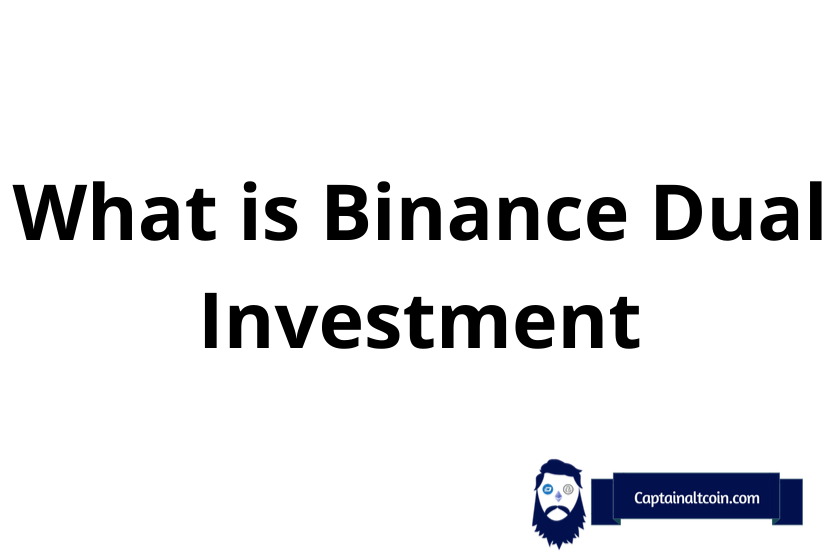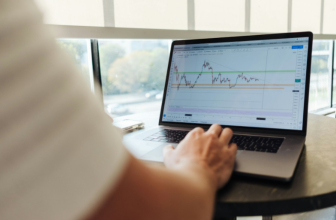
What you'll learn 👉
A Look Into Binance Dual Investment
The crypto market is crazy. Extreme volatility and scary 30% drops can happen from one day to the next. Your portfolio can dwindle and swindle on the waves of the market with you seeing both a lot of red and or a lot of green every day.
That’s why Binance developed their Dual Investment product, making it possible for investors to earn no matter what way the market goes. On it, you can hedge a fixed price and profit from the relative price distances of two crypto assets.
How does that work? Let’s get into it.
What is Binance Dual Investment?
On Binance Dual Investment you can deposit some crypto and earn some enhanced yield based on two assets. The traders bets on both the market going up and down, commit their crypto holding, and lock in a yield. By doing so, regardless of what way the market moves, investors earn a comfortable yield.
The currency investors earn depends on what way the market goes.
The first example is the Up-and-Exercised BTC product, if the price of the underlying asset increases to more than the strike price, then your investment will be converted to the alternate currency (BUSD). If the price of the underlying asset doesn’t exceed the strike price, you’ll still get yield on your deposited cryptocurrency.
With a Down-and-Exercised BUSD or USDT product on the other side, when the value of the underlying asset increases with your earnings above the strike price on the delivery date, you’ll earn your deposit and crypto yield.
But if the price doesn’t exceed the strike price, your investment will be converted into an alternate currency with all the interest earned.
That may all sound a bit daunting but we’ll explain how it all works later on in the meantime let’s clear up some terms:
- Delivery date – The day investors can redeem their crypto deposit and interest
- Strike price – The predetermined price that determines what currency the settlement is paid.
- Settlement price –The average spot price 30 minutes before 08:00 (UTC) on the delivery date.
- Annual percentage yield (APY) – The interest earned with your locked crypto in a Dual Investment product for the term of a year. The number includes compounded interest so if you have an APY of 36.5%, then you’ll have a daily APY of 36.5% / 365 days =0.1%.
- Underlying asset – The asset in a Dual Investment product. So if you deposit BUSD and bet for BTC to go down, BTC is the underlying asset. The Strike price, Ref. Spot price and Settlement Price are all tied to the underlying asset.
How does BTC Dual Investment work?
With BTC Dual Investment BTC holders can hedge their holdings.
The Up-and-Exercised products allow users to sell the underlying asset with interest at a higher price at the time of delivery.
If the settlement price is higher than the strike price, your returns are settled in BUSD”. While if the settlement price is lower than the strike price, the returns will be in BTC.

The Down-and-Exercised products are as you would imagine, the opposite. If the settlement price is lower than the strike price, the returns are settled in BTC. While if the settlement price is higher than the strike price, you’ll earn returns in BUSD.

| Up-and-Exercised | Down-and-Exercised | |
| Deposit cryptocurrencies | BTC | BUSD & USDT |
| Alternate cryptocurrencies | BUSD & USDT | BTC |
| Exercise mechanism | Settlement price ≥ strike price | Settlement price ≤ strike price |
| Subscription period | Any time of the week | |
| APY | Always changing, but locked in once the subscription is completed. | |
| Strike price | Fixed |
When using the Up-and-Exercised BTC product, funds get converted to BUSD at the strike price. The APY is calculated and fluctuates based on the strike price, remaining days, and price volatility.
But it’s good to note that the APY only locks in once you’ve subscribed to a Dual Investment product.
So if you have 1 BTC currently priced at $39.000. If you then subscribe to the Up-and-Exercised Dual Investment product below, with a strike price of $43,000 and a 37.60% APY.

Then by clicking the Subscribe button, you’ll see more details on the product and potential returns. If you type in 1 BTC, the outcomes are displayed underneath.

16 days later, one of two things will happen:
- If the BTC final settlement price is above or equal to $43,000, your 1 BTC is paid out at $43,000 plus the extra interest. You now have $43,752.50 BUSD.
- If the BTC final settlement price is below $43,000, you’ll get your 1 BTC back plus interest worth 0.0175 BTC. You now have 1.0175 BTC.
How does BUSD/USDT Dual Investment work?
The stablecoin-based Dual Investment Down-and-Exercised products give users a chance to purchase the underlying asset with interest at a relatively low price at the time of delivery. If the product exercises, your stablecoins will convert to BTC at the agreed-upon strike price.
Let’s say you have 10,000 USDT and the reference spot price of 1 BTC is $38,555. You subscribe to a 16-day Down-and-Exercised Dual Investment product with a 69.53% APY. The strike price is set to $37,000.

After clicking the [Subscribe] button, you can see the details of the Down-and-Exercised product and the outcomes.

16 days later, you will either have:
- The price above $37,000, in this case you’ll receive the 10,000 USDT deposit and the 323 USDT interest will . Making the total 10,323 USDT.
- On the other hand if the BTC is below or equal to $37,000, your 10,000 USDT is paid out in BTC at a price of $37,000 plus extra interest. You now have 0.279 BTC.
How are the returns calculated?
The returns vary based on whether you exercise the product and your invested currency is converted to the alternate currency.
With Up-and-Exercised the settlement price has to be bigger or equal (≥) the strike price for it to exercise. Conditions for Down-and-Exercised products are as you would expect the opposite.
When exercising your product, you receive the deposited amount and the interest both in the alternate currency. The strike price will be used as the conversion rate. Now let’s break down the calculation:
Up-and-Exercised:
(Subscription Amount * Strike Price) * [1 + (APY% * Deposit Days / 365)]
Down-and-Exercised:
(Subscription Amount / Strike Price) * [1 + (APY% * Deposit Days / 365)]
If the product is not exercised, you get back the original subscription amount and interest in the deposited currency. Your returns will be according to this formula:
Subscription Amount * [1 + (APY% * Deposit Days / 365)]
How to use Binance Dual Investment
Using Binance Dual Investment isn’t that hard. Firstly you have to find the available Dual Investment products on the Binance Earn page, click on the link and follow the step below.
1. Go to the Dual Investment page.
2. Click on the desired product.
3. Input the amount you would like to invest.
4. Click on [Subscribe].
5. It’s that easy, now only you have to wait for the expiry date for your funds to settle
Read also:
- Binance Review– Is Binance Legit and Trustworthy?
- Binance Marketplace Review – What Can You Buy on Binance Marketplace?
- Binance Grid Trading Review – Fees, Strategies, Profitability
- Binance Pool Review – Fees, Payouts, Supported Coins
- Binance P2P Review – Fees, Supported Countries, Payment Methods Overview
- How to Short on Binance Futures? Shorting Crypto on Binance – Full Guide
- 9 Binance Alternatives & Competitors – Are They Better Than Binance?
- How To Stake ETH 2.0 on Binance? Is It Safe & Worth It?
Closing thoughts
With Binance Dual Investment you can earn passive income no matter where the market swings. The product is ideal for long-term investors, the HODLers that want to hedge their position and earn while doing so.
And because the crypto market is known for its crazy volatility, having a way to earn some secure and stable returns is not a bad idea. Binance Dual Investment hedges you from this extreme volatility and also allows you to profit from the distances of these two cryptocurrencies.
Of course, as with every investment vehicle, there’s no reward without risk. One is subscriptions cannot be canceled so there’s a risk your funds will be blocked when volatility is high.
So no matter what, always do your own research and asset risk independently.







